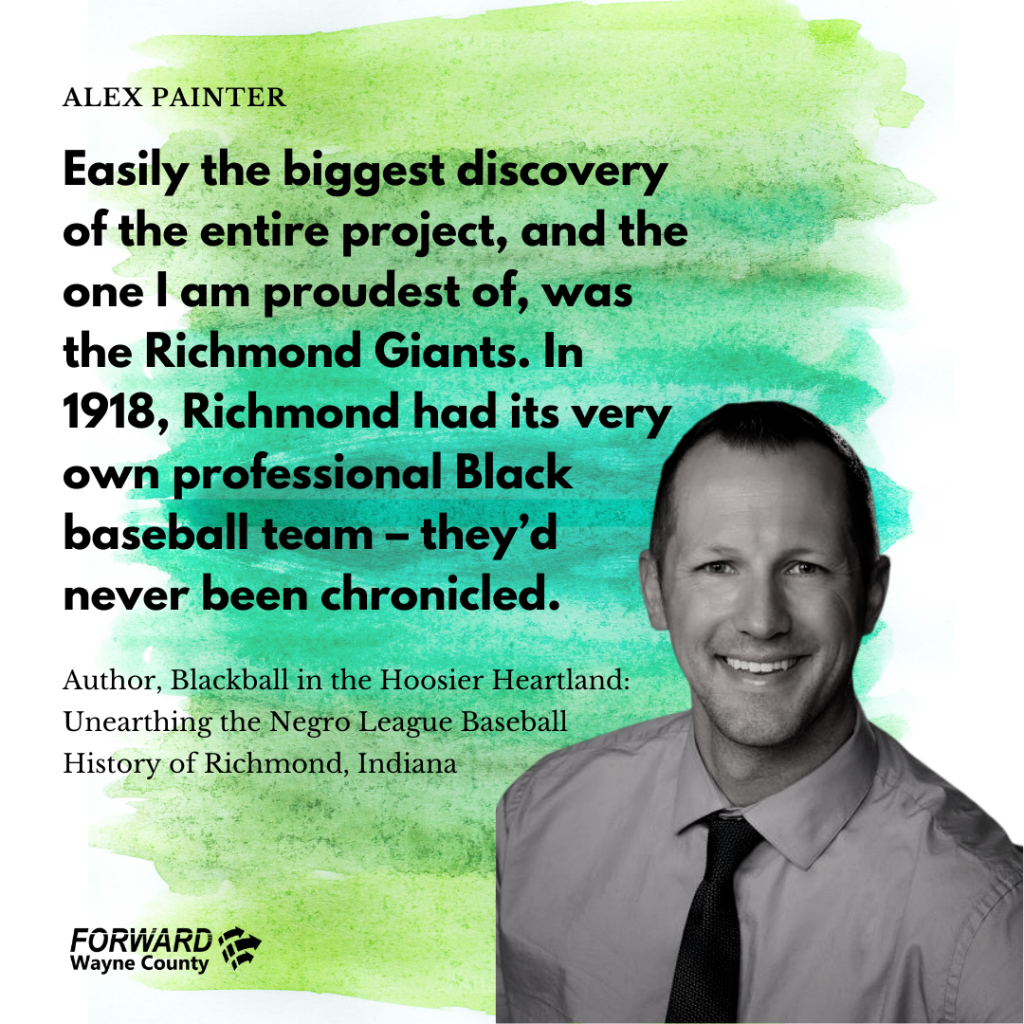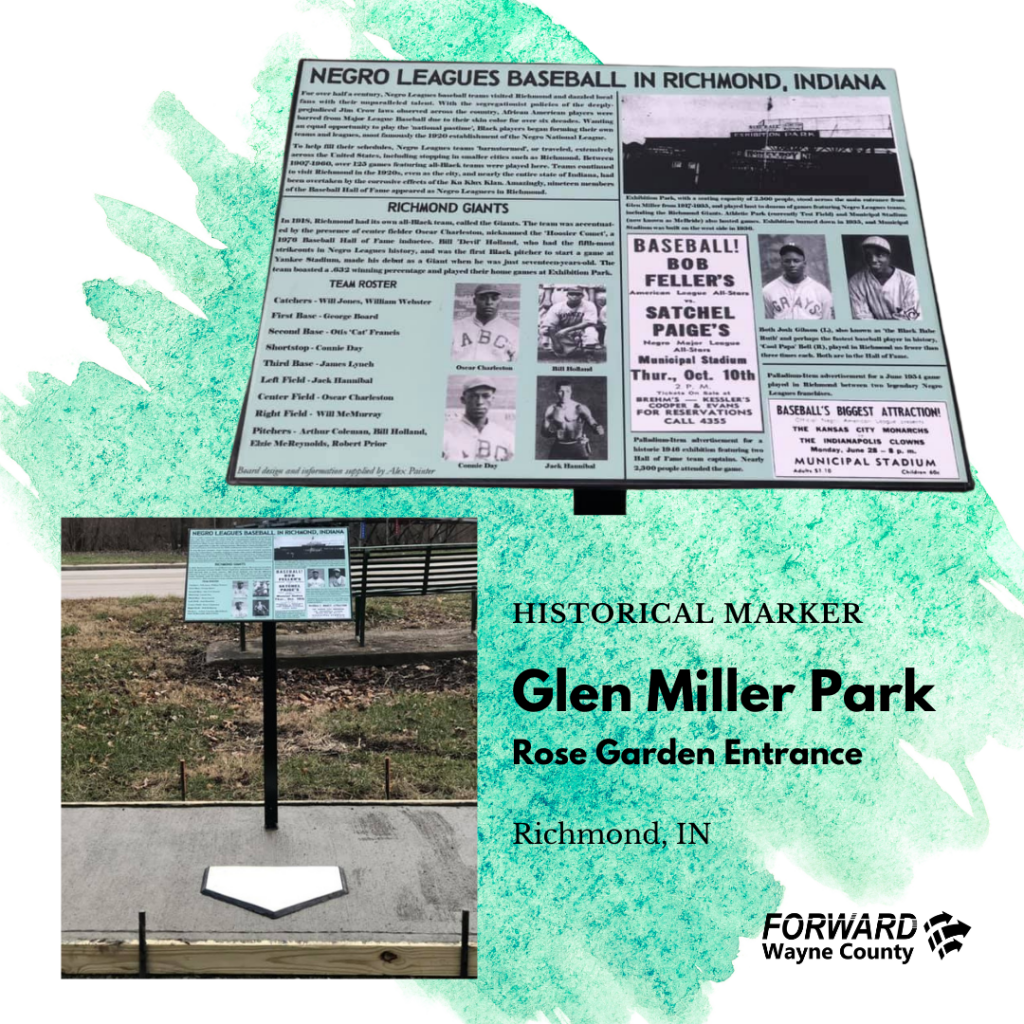Our guest blogger, Alex Painter, is helping Forward Wayne County celebrate Wayne County’s connections to the Negro Leagues. Here is his article:
In early 2019, I embarked on what I thought was going to be a little research project. My goal was to discover and document every game involving a Negro Leagues baseball team that took place in Richmond.
Strange, I know, but I am a lifelong baseball fan and it sounded like a good time.
A Little Background
After being expelled from the ranks of white baseball in the 1880s, Black ballplayers, in the pursuit of social justice and an opportunity at ‘America’s game’, began to form their own teams and leagues.
The institution of Black baseball as a whole is commonly referred to as the Negro Leagues.
Honestly, I wasn’t sure what I was going to find, if anything. Many people may not be aware that Wayne County was a stronghold for the Indiana Ku Klux Klan throughout the 1920s. The Klan’s presence, paired with the emergence of Gennett Records already created an interesting crossroad; the possibility of Negro Leagues baseball certainly could make it more so.
So the List Began
And much to my surprise, it grew…very quickly. Soon, I had found nearly 125 games, featuring professional Negro Leagues teams, played in Richmond beginning in 1907 through 1957. Legendary teams such as the Indianapolis Clowns (played 22 times), the Chicago American Giants (17), and the Homestead Grays (6). In addition, the Kansas City Monarchs (5), and the New York Black Yankees (3) all took their turn here.

Richmond A Perfect Location
Negro Leagues teams, in an effort to help balance their sometimes-unstable financial ledgers, would often play exhibition games in smaller cities like Richmond for additional revenue.
Since Richmond is nestled between Indianapolis, Cincinnati, and Dayton, it allowed for some of the most dazzling baseball talent in America to unassumingly pass through the city on a consistent basis year after year.
The whirlwind life of the Negro Leagues took a toll on the players. They were forced to travel thousands of miles to play games, often in areas they couldn’t find a friendly hotel, to make only a small percentage what white major leaguers made.
Of the 350 Negro Leagues players I confirmed came to the city, 19 (nineteen!) are members of the Baseball Hall of Fame.
This count includes baseball legends such as Josh Gibson, ‘Cool Papa’ Bell, Satchel Paige, Oscar Charleston, Turkey Stearnes, Mule Suttles, Buck Leonard, and Willie Wells. The Hall of Fame numbers only stands to grow.
Local Amateur Team
Though not in the professional ranks, I discovered a local amateur team called the ‘Wayne Colored Base Ball Club’. Founded in 1885 and managed by Will Hunter, they were the very first documented all-Black team in the city. They won two of their three games in 1885. Sadly, the rest of the details about the team are very sparse.
The project also shed light on East Central Indiana’s own Negro Leaguer – John ‘Snowball’ Merida. Born in Spiceland in 1879, Merida was so good that he was permitted to play on otherwise all-white teams for the better part of a decade in the area (this was incredibly rare).
Suiting up for the all-Black Indianapolis ABCs, he was called ‘the terror of all pitchers’, and slugged home runs faster than anyone in the country. He died very young of meningitis in 1911 and was nearly forgotten – even buried in an unmarked grave until 1976.
Richmond Giants
Easily the biggest discovery of the entire project, and the one I am proudest of, was the Richmond Giants. In 1918, Richmond had its very own professional Black baseball team – they’d never been chronicled.
The Giants were stocked with elite ballplayers including Oscar Charleston, Bill Holland, Connie Day, and Jack Hannibal.
Charleston, nicknamed ‘The Hoosier Comet’, is considered one of the best and most fierce players of all time. Stories exist that he yanked a Klansman’s hood off once after a game – the surprised Klansman did nothing, clearly terrified of Oscar.
Holland made his recorded debut as a Richmond Giant when he was only 17. Holland would later become the first Black pitcher to start a game at Yankee Stadium. Only four pitchers across Negro Leagues history struck out more hitters than Holland.
Unfortunately for the Negro Leagues, the price of progress was a steep one. Within just a couple years of baseball’s integration in 1947, starting with Jackie Robinson, most of the teams were forced to close shop.
For decades after, the institution’s legacy was kept alive by a relatively small group of baseball fans.
Fortunately, that has changed recently
In 2020 alone, my findings of Negro Leagues activity here in Richmond were published in a book called Blackball in the Hoosier Heartland: Unearthing the Negro Leagues Baseball History of Richmond, Indiana. It has been particularly rewarding to share this previously-obscured history with our community.
2020 also marked the centennial of the Negro National League’s founding, an event which was celebrated all year. To highlight the commemoration, the Commissioner of Major League Baseball designated the Negro Leagues a ‘major league’ – a respect decades overdue. Accordingly, the statistics of Negro Leaguers will now officially become part of Major League Baseball’s history.
And into 2021, Richmond and Wayne County is memorializing its own history. We now have our own marker in Glen Miller Park to celebrate the Negro Leagues and the Richmond Giants. The marker sits across the street from the former home of Exhibition Park. This was the local stadium where the Giants and many other Negro League greats played.
I invite you to learn more about our city’s intimate, storied history with the absolutely incredible Black baseball leagues – a history that Richmond and Wayne County should not only embrace, but be proud of. Click here for your copy of Blackball in the Hoosier Heartland.

